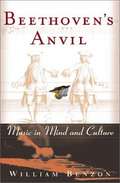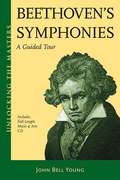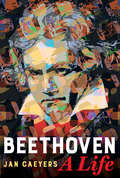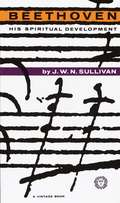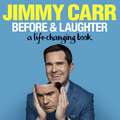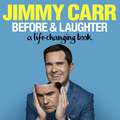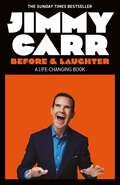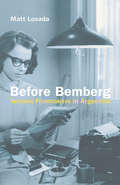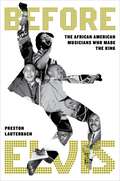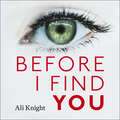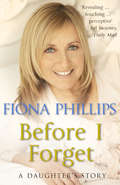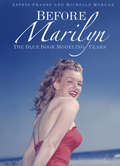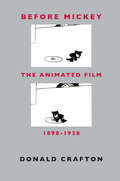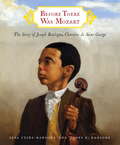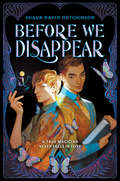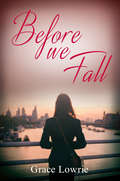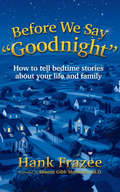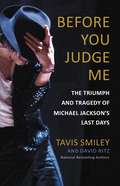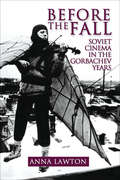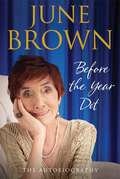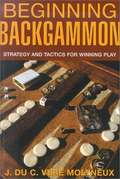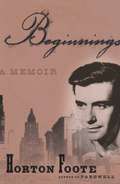- Table View
- List View
Beethoven's Anvil: Music in Mind and Culture
by William BenzonA cognitive scientists and co-founder of the Afro-Eurasian Connection music ensemble, Benzon argues that music connects people not so much to the physical world as to the social world that comes into being through music. It is comprised of groups ranging from two to billions that become a community by dancing and singing. Despite the title, he looks to the future rather than the past, describing building block for communities.
Beethoven's Symphonies: A Guided Tour
by John Bell YoungThe latest release in this value rich book/CD series brings us the great German composer who bridged the classical and romantic eras. In Beethoven's Symphonies: A Guided Tour, readers are treated to a detailed nuts-and-bolts description in easy-to-understand English of each of the famous nine Beethoven symphonies. This book is perfect for anyone who wants to read, listen, and learn more about Beethoven (1770-1827), and discover how this musical genius changed the face of orchestral music forever.
Beethoven, A Life
by Jan CaeyersThis internationally bestselling biography of Ludwig van Beethoven, now translated into English for the first time, offers connoisseurs and newcomers alike an unparalleled story of the composer’s life and works. With unprecedented access to the archives at the Beethoven House in Bonn, renowned Beethoven conductor and scholar Jan Caeyers expertly weaves together a deeply human and complex image of Beethoven—his troubled youth, his unpredictable mood swings, his desires, relationships, and conflicts with family and friends, the mysteries surrounding his affair with the "immortal beloved," and the dramatic tale of his deafness. Caeyers also offers new insights into Beethoven’s music and its gradual transformation from the work of a skilled craftsman into that of a consummate artist. Demonstrating an impressive command of the vast scholarship on this iconic composer, Caeyers brings Beethoven’s world alive with elegant prose, memorable musical descriptions, and vivid depictions of Bonn and Vienna—the cities where Beethoven produced and performed his works. Caeyers explores how Beethoven’s career was impacted by the historical and philosophical shifts taking place in the music world, and conversely, how his own trajectory changed the course of the music industry. Equal parts absorbing cultural history and lively biography, Beethoven, A Life paints a complex portrait of the musical genius who redefined the musical style of his day and went on to become one of the great pillars of Western art music.
Beethoven: His Spiritual Development
by J. W. N. SullivanFrom the Author's Preface:"I believe that in his greatest music Beethoven was primarily concerned to express his personal vision of life. This vision was, of course, the product of his character and his experience. Beethoven the man and Beethoven the composer are not two unconnected entities, and the known history of the man may be used to throw light upon the character of his music." Clifton Fadiman has said of this classic study:"It is the most interesting book on music that I have ever read and it is not written for musical experts; rather for people like myself who like to listen to music but can boast no special knowledge of it. It deals not only with music, on which I do not speak with authority, but with human life in general, about which you and I speak with authority every day of our lives."
Before & Laughter
by Jimmy CarrSelf-help meets memoir in this deeply insightful, fascinating and entertaining audiobook about happiness by one of the country's most treasured comedians. *A memoir and self-help manual by one of the country's most treasured comedians - for anyone who feels stuck in a rut but doesn't have the tools or self-belief to shake things up*In his mid-twenties, Jimmy was bored, boring, unfulfilled and underachieving. He wasn't exactly depressed, but he was very sad. Think of a baby owl whose mum has recently died in a windmill accident. He was that sad. This audiobook tells the story of how Jimmy turned it around and got happy, through the redemptive power of dick jokes. Written to take advantage of the brief window between the end of lockdown and Jimmy getting cancelled for saying something unforgivable to Lorraine Kelly, this audiobook is as timely as it is unnecessary. Because you might be interested in Jimmy's life but he's damn sure you're a lot more interested in your own, Before & Laughter is about both of you. But mainly him. It tells the story of Jimmy's life - the transformation from white-collar corporate drone to fake-toothed donkey-laugh plastic-haired comedy mannequin - while also explaining how to turn your own life around and become the you you've always dreamt of being. At just £20, it's cheaper than Scientology, quicker than therapy, and significantly less boring than church.Before & Laughter contains the answers to all the big questions in life, questions like:· What's the secret to happiness?· Is Jimmy wearing a wig?· What happened with that tax thing? · What's the meaning of life?· Is Jimmy's laugh real?· Can those teeth bite through vibranium?Because it's Jimmy Carr - recently scientifically proved to be the funniest comedian in the UK - there are jokes, jokes and more jokes throughout. If laughter really was the best medicine, the NHS would be handing out this audiobook in Nightingale Hospitals.Fascinating, thoughtful and insightful - are all words that appear in the audiobook.(P) 2021 Quercus Editions Ltd
Before & Laughter
by Jimmy Carr'Stand-up comedy raised me. It taught me all the skills I need for life, except tax accounting.''Very, very funny - a great read' Gary Davies, The Zoe Ball Breakfast Show'Riveting' Daily Mail'An utterly sincere guide for people to achieve bigger things in life' GuardianCheaper than Scientology, quicker than therapy and much less boring than church - this is the hugely funny and insightful book about happiness by top comedian Jimmy Carr, and anyone feeling stuck in a rut should devour it.In his mid-twenties, Jimmy was bored, boring, unfulfilled and underachieving. He wasn't exactly depressed, but he was very sad. Think of a baby owl whose mum has recently died in a windmill accident. He was that sad. This book tells the story of how Jimmy turned it around and got happy, through the redemptive power of dick jokes. Written to take advantage of the brief window between the end of lockdown and Jimmy getting cancelled for saying something unforgivable to Lorraine Kelly, this book is as timely as it is unnecessary. Because you might be interested in Jimmy's life but he's damn sure you're a lot more interested in your own, Before & Laughter is about both of you. But mainly him. It tells the story of Jimmy's life - the transformation from white-collar corporate drone to fake-toothed donkey-laugh plastic-haired comedy mannequin - while also explaining how to turn your own life around and become the you you've always dreamt of being. At just £20, it's cheaper than Scientology, quicker than therapy, and significantly less boring than church.Before & Laughter contains the answers to all the big questions in life, questions like:· What's the secret to happiness?· Is Jimmy wearing a wig?· What happened with that tax thing? · What's the meaning of life?· Is Jimmy's laugh real?· Can those teeth bite through vibranium?And for readers in the West Country: yes, there are pictures (actually, sorry, there are no pictures, but there's a book about a hungry caterpillar you'll love).Because it's Jimmy Carr - recently scientifically proved to be the funniest comedian in the UK - there are jokes, jokes and more jokes throughout. If laughter really was the best medicine, the NHS would be handing out this book in Nightingale Hospitals.Fascinating, thoughtful and insightful - are all words that appear in the book.(P)2021 Quercus Editions Limited
Before & Laughter: The funniest man in the UK’s genuinely useful guide to life
by Jimmy Carr*A memoir and self-help manual by one of the country's most treasured comedians - for anyone who feels stuck in a rut but doesn't have the tools or self-belief to shake things up*In his mid-twenties, Jimmy was bored, boring, unfulfilled and underachieving. He wasn't exactly depressed, but he was very sad. Think of a baby owl whose mum has recently died in a windmill accident. He was that sad. This book tells the story of how Jimmy turned it around and got happy, through the redemptive power of dick jokes. Written to take advantage of the brief window between the end of lockdown and Jimmy getting cancelled for saying something unforgivable to Lorraine Kelly, this book is as timely as it is unnecessary. Because you might be interested in Jimmy's life but he's damn sure you're a lot more interested in your own, Before & Laughter is about both of you. But mainly him. It tells the story of Jimmy's life - the transformation from white-collar corporate drone to fake-toothed donkey-laugh plastic-haired comedy mannequin - while also explaining how to turn your own life around and become the you you've always dreamt of being. At just £20, it's cheaper than Scientology, quicker than therapy, and significantly less boring than church.Before & Laughter contains the answers to all the big questions in life, questions like:· What's the secret to happiness?· Is Jimmy wearing a wig?· What happened with that tax thing? · What's the meaning of life?· Is Jimmy's laugh real?· Can those teeth bite through vibranium?And for readers in the West Country: yes, there are pictures (actually, sorry, there are no pictures, but there's a book about a hungry caterpillar you'll love).Because it's Jimmy Carr - recently scientifically proved to be the funniest comedian in the UK - there are jokes, jokes and more jokes throughout. If laughter really was the best medicine, the NHS would be handing out this book in Nightingale Hospitals.Fascinating, thoughtful and insightful - are all words that appear in the book.
Before Bemberg: Women Filmmakers in Argentina
by Matt LosadaBefore Bemberg: Argentine Women Filmmakers calls into question the historiography of Argentine women filmmakers that has centered on María Luisa Bemberg to the exclusion of her predecessors. Its introductory discussion of the abundant initial participation by women in film production in the 1910s is followed by an account of their exclusion from creative roles in the studio cinema, which was only altered by the opportunities opened by a boom in short filmmaking in the 1960s. The book then discusses in depth the six sound features directed by women before 1980, which, despite their trailblazing explorations of the perspectives of female characters, daring denunciations of authoritarianism and censorship, and modernizing formal invention, have been forgotten by Argentine film history. Looking at the work and roles of Eva Landeck, Vlasta Lah, María Herminia Avellaneda and María Elena Walsh and Maria Bemberg, the book recognizes these filmmakers’ contributions at a significant moment in which movements to eliminate gender-based oppression and violence in Argentina and elsewhere are surging. Watch some of the films discussed in the book with English subtitles (https://www.youtube.com/channel/UCF_6F4am5024rklIWwExUVA?view_as=subscriber).
Before Elvis: The African American Musicians Who Made the King
by Preston LauterbachIn this thought-provoking book, the Black musicians who influenced Elvis Presley's music finally receive recognition and praise. After Baz Luhrmann&’s movie, Elvis, hit theaters, audiences and critics alike couldn't help but question the Black origins of Elvis Presley&’s music and style, reigniting a debate that has been circling for decades. In Before Elvis: The African American Musicians Who Made the King, author Preston Lauterbach answers these questions definitively, based on new research and extensive, previously unpublished interviews with the artists who blazed the way and the people who knew them. Within these pages, Lauterbach examines the lives, music, legacies, and interactions with Elvis Presley of the four innovative Black artists who created a style that would come to be known as Rock &’n&’ Roll: Little Junior Parker, Big Mama Thornton, Arthur &“Big Boy&” Crudup, and mostly-unknown eccentric Beale Street guitarist Calvin Newborn. Along the way, he delves into the injustices of copyright theft and media segregation that resulted in Black artists living in poverty as white performers, managers, and producers reaped the lucrative rewards. In the wake of continuing conversations about American music and appropriation, Before Elvis is indispensable.
Before I Find You: The gripping psychological thriller that you will not stop talking about
by Ali KnightPERFECT FOR FANS OF KILLING EVE, THE GUILTY WIFE AND FRIEND REQUEST'A sharp, witty psychological suspense with a difference. Be prepared for a fast ride and an unexpected destination' Jane Corry, Sunday Times Bestselling author of The Dead ExMaggie is a husband watcher. A snooper, a marriage doctor, a killer of happy-ever-afters. She runs her own private detective agency specialising in catching out those who cheat. And she's very good at it. Until Helene walks through her door.Helene is a husband catcher. A beautiful wife, a doting stepmother, a dazzling presence at parties. She counts herself lucky to have married one of the most eligible men in town - Gabe Moreau. Until she sees something that threatens her little family of three.Alice is a perfect daughter. Apple of her father's eye, a kind stepchild to Helene, a tragic daughter of a dead mother. She lives a sheltered but happy life. Until she finds a handwritten note on her father's desk: 'You owe me. I'm not going away.'All three women suspect Gabe Moreau of keeping secrets and telling lies. But not one of them suspects that the truth could result in murder . . .'Ridiculously addictive and compelling - I tore through this crisp, taut character-driven delight in one day!' Angela Clarke, Sunday Times bestselling author of Follow Me, Watch Me and Trust Me'Fabulously whip-smart and twisty with a feisty female lead who crackles off the page' Eve Chase, author of The Vanishing of Audrey WildePRAISE FOR ALI KNIGHT'Crackles from first page to last' Daily Mail'A suspenseful Hitchcockian tale . . . [one of the] top ten crime books to take on holiday' Telegraph'Tightly-plotted, high-pitched psychological thriller . . . what Ali Knight does so successfully is broach the great divide between public and private space' Daily Mirror'A clever thriller . . . a gripping read' Sunday Mirror'Pacey and disquieting, Knight's debut hints she might be a successor to Sophie Hannah's queen of suspense crown' Stylist'A really enjoyable read' Number one bestselling author, Martina Cole'Top notch suspense!' Number one bestselling author, Lisa Gardner'Like The Girl on the Train, brilliantly twisty and compulsive' Elizabeth Fremantle, author of The Poison Bed
Before I Forget
by Fiona PhillipsFiona Phillips is one of our best-loved television presenters. Well-known for being warm, chatty and down to earth, she attended her local comprehensive in Southampton before studying English in Birmingham. For over twelve years she presented GMTV, during which time she interviewed some of the most famous and influential people on the planet, from film stars to royalty, politicians to local heroes. But in August 2008 Fiona announced that she was to quit the job she loved, revealing that her father, Phil, had been diagnosed with Alzheimer's just a year after her mother had died of the same disease and that she had decided to devote more time to him and to her family. Before I Forget is a wonderfully honest account of growing up in the 1960s and 70s within a complex family. During her childhood her father could sometimes be distant and demanding which both saddened her and drove her to succeed, her mother always the devoted wife and the steady heart of the family. When Fiona lands the job at GMTV she revels in how proud they are of her achievement. When her mother and then her father succumb to Alzheimer's we share in Fiona's sadness as she movingly describes watching them fade away, one moment interviewing George Clooney the next taking a call from Pembrokeshire Social Services to say that her mother had wandered away from her care home.Before I Forget is an extraordinary book which will resonate with Fiona's millions of fans and the millions of people who day-by-day are going through, or have gone through, the same experiences.
Before Marilyn
by Michelle Morgan Astrid FranseBefore Marilyn tells the story of Marilyn Monroe's modelling career, during which time she was signed to the famous Blue Book Agency in Hollywood. The head of the agency, Miss Emmeline Snively, saw potential in the young woman and kept detailed records and correspondence throughout their professional relationship and beyond. On the day of Monroe's funeral, Snively gave an interview from her office, talking about the girl she had discovered, before announcing, rather dramatically, that she was closing the lid on her Marilyn Monroe archive that day - to 'lock it away forever'. This archive was purchased by Astrid Franse, and together with bestselling Marilyn Monroe biographer Michelle Morgan they draw on this collection of never-before-seen documents, letters and much, much more. Before Marilyn explores an aspect of Monroe's life that has never been fully revealed - by charting every modelling job she did, and illustrating the text with rare and unpublished photographs of the young model and her mentor.
Before Mickey: The Animated Film 1898–1928
by Donald CraftonThis witty and fascinating study reminds us that there was animation before Disney: about thirty years of creativity and experimentation flourishing in such extraordinary work as Girdie the Dinosaur and Felix the Cat. Before Mickey, the first and only in-depth history of animation from 1898-1928, includes accounts of mechanical ingenuity, marketing and art. Crafton is equally adept at explaining techniques of sketching and camera work, evoking characteristic styles of such pioneering animators as Winsor McCay and Ladislas Starevitch, placing work in its social and economic context, and unraveling the aesthetic impact of specific cartoons. "Before Mickey's scholarship is quite lively and its descriptions are evocative and often funny. The history of animation coexisted with that of live-action film but has never been given as much attention."—Tim Hunter, New York Times
Before Mickey: The Animated Film, 1898-1928
by Donald CraftonThis witty and fascinating study reminds us that there was animation before Disney: about thirty years of creativity and experimentation flourishing in such extraordinary work as Girdie the Dinosaur and Felix the Cat. Before Mickey, the first and only in-depth history of animation from 1898-1928, includes accounts of mechanical ingenuity, marketing and art. Crafton is equally adept at explaining techniques of sketching and camera work, evoking characteristic styles of such pioneering animators as Winsor McCay and Ladislas Starevitch, placing work in its social and economic context, and unraveling the aesthetic impact of specific cartoons. "Before Mickey's scholarship is quite lively and its descriptions are evocative and often funny. The history of animation coexisted with that of live-action film but has never been given as much attention. "—Tim Hunter, New York Times
Before There Was Mozart: The Story of Joseph Boulogne, Chevalier de Saint-George
by James E. Ransome Lesa Cline-RansomeThe musical superstar of 18th-century France was Joseph Boulogne--a black man. This inspiring story tells how Joseph, the only child of a black slave and her white master, becomes "the most accomplished man in Europe." After traveling from his native West Indies to study music in Paris, young Joseph is taunted about his skin color. Despite his classmates' cruel words, he continues to devote himself to his violin, eventually becoming conductor of a whole orchestra. Joseph begins composing his own operas, which everyone acknowledges to be magnifique. But will he ever reach his dream of performing for the king and queen of France? This lushly illustrated book by Lesa Cline-Ransome and James E. Ransome introduces us to a talented musician and an overlooked figure in black history.
Before We Disappear
by Shaun David HutchinsonA Junior Library Guild Gold Standard Selection!It’s a new star-crossed romance about the magic of first love from the acclaimed author of We Are the Ants and Brave Face, Shaun David Hutchinson.Jack Nevin’s clever trickery and moral flexibility make him the perfect assistant to the Enchantress, one of the most well-known stage magicians in turn-of-the-nineteenth-century Europe. Without Jack’s steady supply of stolen tricks, the Enchantress’s fame would have burned out long ago.But when Jack’s thievery catches up to them, they’re forced to flee to America to find their fortune. Luckily, the Enchantress is able to arrange a set of sold-out shows at Seattle’s Alaska–Yukon–Pacific World’s Fair Exposition. She’s convinced they’re going to rich and famous until a new magician arrives on the scene. Performing tricks that defy the imagination, Laszlo’s show overshadows the Enchantress, leaving Jack no choice but to hunt for the secrets to his otherworldly illusions. But what Jack uncovers isn’t at all what he expected.Behind Laszlo’s tricks is Wilhelm—a boy that can seemingly perform real magic. Jack and Wilhelm have an instant connection, and as the rivalry between the Enchantress and Laszlo grows, so too does Jack and Wilhelm’s affection. But can Jack choose between the woman who gave him a life and the boy who is offering him everything?It’s a stirring tale about the magic of love from award-winning author Shaun David Hutchinson.
Before We Fall: The Wildham Series (The Wildham Series #2)
by Grace LowrieWhen quiet Cally, an amateur ballet dancer, is suddenly diagnosed with cancer she runs away from her boyfriend Liam, her job in a call centre and her safe life in Wildham – in order to experience ‘real’ life in London. Taking a job as a stripper and flat-sitting in the top of an office tower she meets her obnoxious neighbour Bay; a tattooed, drug-taking, suicidal artist, haunted by the death of those close to him. Despite their differences, the two strike up a friendship – Bay pushes Cally to try new things while Cally provides Bay with a muse – and they fall in love. But their secrets threaten to tear them apart and time is running out...
Before We Fall: The Wildham Series (The\wildham Ser. #2)
by Grace LowrieWhen quiet Cally, an amateur ballet dancer, is suddenly diagnosed with cancer she runs away from her boyfriend Liam, her job in a call centre and her safe life in Wildham – in order to experience ‘real’ life in London. Taking a job as a stripper and flat-sitting in the top of an office tower she meets her obnoxious neighbour Bay; a tattooed, drug-taking, suicidal artist, haunted by the death of those close to him. Despite their differences, the two strike up a friendship – Bay pushes Cally to try new things while Cally provides Bay with a muse – and they fall in love. But their secrets threaten to tear them apart and time is running out...
Before We Say "Goodnight": How to Tell Bedtime Stories About Your Life and Family
by Hank FrazeeA unique way to turn bedtime stories into an opportunity to strengthen our bond with our children. Before We Say &“Goodnight&” will show you how to captivate your child&’s imagination with a subject they literally can&’t get enough of—you. In this book, you&’ll discover an easy-to-learn three-step method to turn your life experiences, and those of your family, into great bedtime stories, all without notes or memorization. Best of all, you&’ll make bedtime one of the happiest parts of the day. &“Our children and grandchildren want to know who we really are. This book provides a wonderful method to share our life with those we love. It&’s out of this world!&” —Buzz Aldrin, astronaut
Before You Judge Me: The Triumph and Tragedy of Michael Jackson's Last Days
by David Ritz Tavis SmileyA powerful chronicle of the sixteen weeks leading up to King of Pop Michael Jackson's deathMichael Jackson's final months were like the rest of his short and legendary life: filled with deep lows and soaring highs, a constant hunt for privacy, and the pressure and fame that made him socially fragile and almost--ultimately--unable to live. With the insight and compassion that he brought to his bestselling telling of Martin Luther King, Jr.'s final year, Tavis Smiley provides a glimpse into the superstar's life in this emotional, honest, yet celebratory book. Readers will witness Jackson's campaign to recharge his career--hiring and firing managers and advisors, turning to and away from family members, fighting depression and drug dependency--while his one goal remained: to mount the most spectacular series of shows the world had ever seen. BEFORE YOU JUDGE ME is a humanizing look at Jackson's last days.
Before the Fall: Soviet Cinema in the Gorbachev Years
by Anna LawtonAn expanded edition of Kinoglasnost that examines the fascinating world of Soviet cinema during the yeas of glasnost and perestroika in the 1980s.In Before the Fall, Anna Lawton shows how the reforms that shook the foundations of the Bolshevik state and affected economic and social structures have been reflected in the film industry. A new added chapter provides a commentary on the dramatic changes that marked the beginning of democracy in Russia.Soviet cinema has always been closely connected with national political reality, challenging the conventions of bourgeois society and educating the people. In this pioneering study, Lawton discusses the restructuring of the main institutions governing the industry; the abolition of censorship; the emergence of independent production and distribution systems; the dismantling of the old bureaucratic structures and the implementation of new initiatives. She also surveys the films that remained unscreened for decades for political reasons, films of the new wave that look at the past to search out the truth, and those that record current social ills or conjure up a disquieting image of the future.“What makes Kinoglasnost pre-eminent among current studies of the subject is that sustained attention Lawton pays to changes in the formal organization of Soviet cinema and in the cinema industry.” —Julian Graffy, Sight and Sound“The author constructs a complex, multilayered narrative of a steady and significant movement toward radical change in Soviet society, an account of the growing anxiety and the hope experienced by Russian filmmakers and the intelligentsia.” —Ludmila Z. Pruner, Slavic and East European Journal
Before the Year Dot
by June BrownAt sixteen I was very interested in palmistry. The fate line on my right palm had a distinct break at the age of thirty. It broke into two parts that ran for a quarter of an inch on parallel tracks. I used to look at it and wonder, 'What will happen to me when I am thirty that will change my life?' Of course, it was Johnny's death. But, in fact, my life was changed twice by death. June Brown is an institution - a classically trained actress and showbiz veteran, who has undoubtedly lived a full and fascinating life. One of the few national treasures left not to have told her story, she is much-loved for her role as the chain-smoking Dot Branning in the long-running BBC soap, EastEnders, a character she has played with dedication and skill for over 25 years. Before the Year Dot traces her colorful childhood in Ipswich with her beloved sisters, through the war with the WRENS, to her days as a gifted stage actress trained by the likes of Laurence Olivier, Michel Saint-Denis and Glen Byam-Shaw. Her legendary tours of the Young and Old Vic Schools saw her play some of her most memorable parts and cement her acting credentials. In this hugely anticipated memoir, June recounts an enthralling early life. But it is also a life marked by two deaths that changed June forever - once when she lost her beloved sister, Marise, and a second time with the loss of her adored husband, Johnny. June Brown tells her colorful story with candor and skill, and in her own words.
Beginning Backgammon: Strategy and Tactics for Winning Play
by J. Du C. Vere MolyneuxWhether you're looking for a pleasant family pastime or a competitive gambling game, backgammon can supply the answer. The combination of skill and luck that is at the heart of the game enables players of differing skill and aptitude to play together without boredom or one-sided results. BEGINNING BACKGAMMON, as its title suggests, is intended for the complete beginner at backgammon. In simple language and clear, easy-to-follow illustrations, it introduces this exciting, popular game at all its levels. Covering the basic rules of the game, elementary tactics; and overall strategy (including dice probabilities and gambling aspects such as the right use of the "doubling cube"), BEGINNING BACKGAMMON includes sample games used to show backgammon theories in practice. Alternative games that can be played on the backgammon board are also included.
Beginnings
by Horton FooteSince 1939, Horton Foote, "the Chekhov of the small town," has chronicled with compassion and acuity the experience of American life both intimate and universal. His adaptation of Harper Lee's To Kill a Mockingbird and his original screenplay Tender Mercies earned him Academy Awards. He has won a Pulitzer Prize, the Gold Medal for Drama from the American Academy of Arts and Letters, the PEN/Laura Pels Foundation Award for Drama, and the President's National Medal of Arts. Beginnings is the story of Foote's discovery of his own vocation. He didn't always want to write. When he left Wharton, Texas, at the age of sixteen to study at the Pasadena Playhouse, Foote aspired to be an actor. He remembers the terror and excitement of leaving home during the Depression, his early exposure to the influences of German theater, and the speech lessons he took to "cure" him of his Southern drawl. He eventually arrives in New York to search for acting jobs and to study with some of the great Russian and American teachers of the 1930s. But after mixed results on the stage, he finally recognizes his true passion, writing. From Martha Graham to Tennessee Williams, from Agnes de Mille to Lillian Gish, Horton collaborates with great artists in both dance and theater. The world he describes of fierce commitment and passion regardless of financial rewards is both captivating and inspiring. Through it all Horton maintains his genuine Southern charm, and he often travels home to Wharton, the town that nurtured him as a storyteller and has inspired his writing for the past sixty years. From one of the most moving and distinctive voices of our time, Beginnings is a rare, personal look at a fascinating era in American life, and at the making of a writer.
Beginnings: A Memoir
by Horton FooteSince 1939, Horton Foote, "the Chekhov of the small town," has chronicled with compassion and acuity the experience of American life both intimate and universal. His adaptation of Harper Lee's To Kill a Mockingbird and his original screenplay Tender Mercies earned him Academy Awards. He has won a Pulitzer Prize, the Gold Medal for Drama from the American Academy of Arts and Letters, the PEN/Laura Pels Foundation Award for Drama, and the President's National Medal of Arts. Beginnings is the story of Foote's discovery of his own vocation. He didn't always want to write. When he left Wharton, Texas, at the age of sixteen to study at the Pasadena Playhouse, Foote aspired to be an actor. He remembers the terror and excitement of leaving home during the Depression, his early exposure to the influences of German theater, and the speech lessons he took to "cure" him of his Southern drawl. He eventually arrives in New York to search for acting jobs and to study with some of the great Russian and American teachers of the 1930s. But after mixed results on the stage, he finally recognizes his true passion, writing. From Martha Graham to Tennessee Williams, from Agnes de Mille to Lillian Gish, Horton collaborates with great artists in both dance and theater. The world he describes of fierce commitment and passion regardless of financial rewards is both captivating and inspiring. Through it all Horton maintains his genuine Southern charm, and he often travels home to Wharton, the town that nurtured him as a storyteller and has inspired his writing for the past sixty years. From one of the most moving and distinctive voices of our time, Beginnings is a rare, personal look at a fascinating era in American life, and at the making of a writer.
